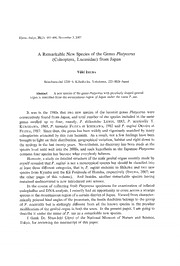
A Remarkable New Species of the Genus Platycerus (Coleoptera, Lucanidae) from Japan PDF
Preview A Remarkable New Species of the Genus Platycerus (Coleoptera, Lucanidae) from Japan
Elytra,Tokyo,35(2):491-496,November3,2007 ARemarkableNewSpeciesoftheGenusPlatycerus (Coleoptera, Lucanidae) fromJapan Yuki IMURA Shinohara-cho1249-8, Kohoku-ku, Yokohama,222-0026Japan Abstract AnewspeciesofthegenusPlatyceruswithpeculiarlyshapedgenital organisdescribedfromthemountainousregionofJapanunderthenameP.sue. It was jn the1980sthat twonewspeciesof thelucanidgenusPlatyceruswere consecutivelyfound fromJapan,andtotalnumberofthespeciesincludedinthesame genus swelled up to four, namely, P delicatulus LEWIS, 1883, P acutico11is Y. KUROSAWA, 1969, P kawadai FUJITAet ICHIKAWA, 1982 andP.Sugitai OKUDAet FUJITA,1987. Sincethen,thegenushasbeenwidelyandvigorouslysearchedbymany coleopteristsattractedbythiscutelucanids. Asaresult,notafewfindingshavebeen broughttolightontheirdistribution,geographicalvariation,habitatandrightdownto theecologyinthelast twentyyears. Nevertheless,nodiscoveryhasbeenmadeat the specjesleve1untilwell intothe2000s,andsuchhypothesisastheJapanesePlatycerus containsfourspecieshasbecomewhateverybodybelieves. However,astudyondetailedstructureofthemalegenitalorganrecentlymadeby myselfrevealedthatP.sugitai isnotamonotypica1speciesbutshouldbeclassifiedinto at least threedifferentcategories, that is,P.sugitaiendemictoShikokuandtwonew speciesfromKyushuandtheKiiPeninsulaofHonshu, respectively(IMuRA,2007;see theother pages of this volume). And besides, another remarkablespecies having remained undiscovered isnow introducedintoscience. InthecourseofcollectingfreshPlatycerusspecimensforexaminationofinflated endopha11usandDNAanalysis,Irecentlyhadanopportunitytocomeacrossastrange speciesinthemountainousregionofacertaindistrictofJapan. Viewedfromcharacter- isticallypointedhindanglesofthepronotum,thebeetledoubtlessbelon9stothe9rouP of P acutico11isbut isstrikingly different fromall theknownspeciesin thepeculiar modificationofthegenitalorganinboththesexes. Inthepresentpaper,Iamgoingto describeit under thenameofP.sueasaremarkablenewspecies. I thank Dr. Shun-Ichi U直NO of the National Museum of Nature and Science, Tokyo, forreviewingthemanuscriptof thispaper. 492 Yuki IMURA Platycerussue IMuRA,sp n ov. [Japanesename:Takane-ruri-kuwagata] (Figs.1-3) Male. Length (includingmandibles):10.2-12.1 (arithmeticmean:10.76)mm. Bodyabovefineblueandhardlybearinggreenish tinge;mandibles,palpi,antennae, knees,protibiaeandproximalpartsoftarsialmostblack;distalpartsoftarsiandclaws dark brown; meso- andmetatibiaeand femoraexcept for thedistalends yellowish brown;venterblack, thoughlateralsidesofabdominalsternitesVIIusuallybrownish. Headalmostasintheothermembersofthegenus;itsdorsalsurfacenotsocoarsely scattered withsmall punctureswhicharenot con uent withoneanother;mandibles (Fig.1-c) verysmallandshort,notconcaveaboveinbasalportions,not formjnga longitudinalridgealonginnermargins,withtheoutermarginsroundlyarcuatethrough_ outandnotsubangulateat theapicalthirdasisoftenobservedinalliedspecies;apical portions rather acutely tapering towards the tips which aresharply pointed; inner marginsofretinaculairregularlyserrated,with threetofiveteethoneachside. Pronotumtransverse, 1.47-1.58 (arithmeticmean: 1.52) timesaswideas long, widest at or alittlebehindthemiddle; lateralsidesroundlyarcuateandirregularly serratedinapicalportions, faintlyangulateat thewidestpart, thenratheracutelyand straightlyconvergent towardshindangleswhichareprotrudent laterallywiththetips rathersharplypointed; front anglesremarkablyprotrudinganteriadandtriangularly pointed; disc moderately co nvex above, rather remarkably depressed along lateral marginsnear front angles, with thediscscatteredwithpunctureswhicharealittle smaller insizethan thoseonhead. Elytraratherrobust foramemberofthegenus,1.68-1.77(arithmeticmean:1.70) timesaslongaswide,widestobviouslybehindthemiddle,withthelateralsidesnearly straight and slightly divergent posteriad in apical halves and roundly arcuate near apices;shouldersdistinctandsubangulate,withaverysmallhumeraltoothoneachside; surfaceratheruniformlyscatteredwithsmallpunctureswhichareoftenarrangedin longitudinalrows;intervalsratherroughlyrugose-striatenearthesuturalpartinmedian portions. MalegenitalorganasshowninFigs 3a-f;apicalmarginofbasalpieceonventral sidenottriangularlypointedbutsubtrapezoidallyprotrudedapicad;paramerewiththe lateralsidenotstronglyin atedinbasalportion,itsinnermarginonventralsidefaintly emarginatethroughout,andinner-apicalangleeffacedinbothventralandlateralviews; viewed dorsally, inner margin of each paramere widely and roundly emarginate throughout,withtheinner-basalangleobliquelyprotrudent;aedeaguswiththeproximal Partasin theothermembersofthegenus;distalpartwineglass-likeinshape,deeply re-entrantapicadat themiddletoformalargeU-shapedsclerotizedplatein ventral view; itssurfacerathercoarselyand transverselywrinkled thoughnoobliquekeel is developed, with theperipheralportionnear thebordersbetweenendopha11us rather coarselyscatteredwithsmallgranules;endopha11uswhenfullyinflatedlarge,robustand RemarkableNewPlatycertisfromJapan 493 b b l 2 a Figs.1-2. Platycerussuesp nov;1, (holotype);2, (paratype). - a,Habitusindorsalview b,dittoinventralview;c,mandiblesindorsalview nearly rectangularly inflexed at themiddle; itsbasal portionstrongly inflated,stoutly producedventrad,withapairofsmallprotrusionsatthetip;medianportioncylindrical, nearlyparallel-sided indorsal view, withapairof larger membranousprojectionson both sidesof flagellum; flagellum indicated by longitudinallyset linear scleritecom- pletelyattached to themembranouswall of endopha11us, thoughvestigial in thearea between the paired projections in mid-endopha11us; apical portion of endopha11us cylindrical andstout, noaccessory inflationbeingdeveloped, with the tiphemispheri- ca11y rounded. Female. Length(includingmandibles):9.8-21.1mm. Bodyabovebrassywith agreenishtingeonheadandpronotum;antennaealmostblack,mandibles,palpi,knees, protibiaeand tarsi reddish black to reddishbrown;meso- and metatibiae and femora except for the distal ends dark yellowish brown; venter black, with a remarkable greenish tingeonmetasterna;abdominalsternitesdark reddishbrown. 494 Yuki IMURA Headsmaller thaninmale,withthedorsalsurfacemuchmorecoarselyscattered with larger punctureswhich are confluent with one another in anterior and lateral portions;mandibles(Fig 2-c)smallandshort,withthebasicstructurealmostasinthe othermembersofthesamegenus. Pronotumtransverse,1.41timesaswideaslong, widest nearlyat themiddle, and moreacutelynarrowedtowardsapexthan towardsbase; frontanglesmuchshorterand lessstronglyprotrudedanteriad than inmale, hindanglesasinmale; lateralmargins irregularly anddistinctly serrated; discscatteredwith larger puncturesthan inmale, which areconfluent withoneanotherin lateralportions. Elytramuch robuster than inmale, 1.50timesaslongaswide, widest obviously behindthemiddle,withthesideseitherstraightorveryslightlyemarginateforashort behind shoulders, moderately arcuate from behind themiddle to apical tips; way shouldersdistinct andsubangulate, withasmall humeral tooth oneachside;surface ratheruniformlyscatteredwithsmallpunctureswhichareoftenarranged in longitudi- nalrows;intervalsonlyfaintlyrugose-striatenear thesuturalpart inmedianportions. FemalegenitalorganasshowninFigs 3g-f;gonocoxiteratherstout,subovoidin shape,with thelateralsidesgraduallydivergent towardsthebasein ventral view; its inner-apical corner not angulatebut nearlystraight or faintly rounded, outer corner effaced. Typeseries. Holotype: ,mountainousregionofJapan,collectedbyY.IMURAin 2007, tobepreserved intheDepartmentofZoology, NationalMuseumof Natureand Science,Tokyo. Paratypes:15 10 早,samedataasfor theholotype,preservedin , thecollectionof Y. IMURA (Yokohama). Notes. Thepresentnewspeciesisreadilydiscriminatedfromalltheotherspecies ofthegenusbypeculiarlyshapedmalegenitalorganasdescribedabove. Concerningthe female genitalia, thenewspecies differs from thealliedspecies in characteristically featuredgonocoxitewhichisrobusterandmuchlessacutelynarrowedtowardstheapex. Also from theexternal appearance, thenewspeciesisdistinguishable fromtheallied species in the following respects: 1) outermarginsofmalemandiblesusuallymore roundlyarcuate throughout andoccasionallysubangulateasinmost individualsofP acutico11isandP.sugltai;2) innermarginsofmalemandiblesnot forminglongitudinal ridgeas inP acutico11isandP.sugitai; 3)pronota1discmorewidelydepressedalong lateralmarginsnear frontangles;4)elytraalittlerobuster,with thedisclessfinelyand alittlemoresparselyrugose-striatethaninP.sugltai,thoughrathersimilar insculptural patterntoacertaingeographical raceofP acutico11is. Thesediagnosticpointsarealso available for two speciesallied toP.sugltai described from Kyushuand the Kii new Peninsulaontheother pagesof thisvolume (IMuRA, 2007). Fig.3. GenitalorganofPlatycerussuesp nov;a-f,malegenitaliawith fullyinflatedendophalius;g- l, femalegenitalia. - a, Ventralview;b, rightsubventra1view;c, rightlateral view; d, right subdorsalview;e, apicalview; f,rightsubdorsalview;g,1eftlatera1view;h,subapicalview,1,left gonocoxiteinventral view. RemarkableNewPlatycerusfromJapan 495 496 Yuki IMURA The distribution of the new species is considered to be restricted to the high altitudinalareaonacertainmountainrange,anditshabitatmightbeeasilydamagedif manycollectorsmakearushfor there.SincethegenusPlatycerusisimmenselypopular amongmaniacsinJapan,it ishighlyplausiblethatanannouncementofdetailed locality causes a rush of collectors, and in its turn givesanadverseeffect to thehabitual environment. ThisiswhyIrefrainfromrevealingtheexactlocalityinthepresentpaper. Itsdetailswillbebroughttolightafterweknowmoreonthedistributionalrange,local andindividualvariations,habitatandecologyofthenewspecies,sothatwecanmake aprospectsfor theprotectionofthisvaluablelucanid. Etymology. Thenameofthenewspecies,Sue [su:orsu],comesfromanickname ofmywife,Masumi,ProfessorofInternationalUniversityofHealthandWelfare,who isalwayssympatheticabout myentomologicalactivities. 要 約 井村有希:本邦から発見されたルリクワガタ属の顕著な1新種. - 本邦の山岳地帯から得ら れたルリクヮガタ属の1種を新種と認め, タカネルリクワガタPlatycerussueという新名を与え て記載した. 形態学的には, 前胸背板の後角が尖るコルリクワガタ群に属するが, 雌雄交尾器の 形態がおおきく異なるため, 既知種からの識別はきわめて容易である. 新種名の「ヌー」 は, 筆 者の妻の愛称にちなむ. 本種はこれまで, 某山塊の一角から得られているにすぎず, きわめて局 地的な分布を示すものと考えられる. ルリクワガタ属は愛好家からの人気がひじょうに高いグ ループであるため, 20年ぶりに本邦から発見された顕著な新種であることや, 生息範囲が限定さ れている可能性が高いことなどを考慮すると, 産地の公表は採集者の殺到と乱獲に伴う現地の環 境破壊を招き, ひいては社会問題にまで発展する可能性が高い. したがって, 本種の分布範囲や 生息環境, 生態などに関するより詳細な知見が得られ, その保全対策に対する目処が立つまで, 具体的な産地名の公表は差し控えておくことにしたい. References FUJITA,H.,&T.IcHIKAwA,1982. AnewspeciesofthegenusPlatycerttsGEOFFROYf「omCent「alJapan (Lucanidae). Elytra,Tokyo,10:1-8. IMuRA, Y.,2007. Endopha11icstructureof thegenusPlatycerus(Coleoptera,Lucanidae)ofJapan,with descriptionsoftwonewtaxa. Elytra,Tokyo,35:471-489. KUROSAWA,Y.,1969. Arevisionof thegenusPlatycerusGEoFFRoYinJapan.Bull natn.Sci.Mus.,Tokyo, 12: 475 - 485. LEWIS,G.,1883. OntheLucanidaeofJapan. Trattsent.Soc.Lend.,1883:338-339. OKUDA,N.,&H.FUJITA,1987. AnewspeciesofthegenusPlatycerusGEOFFROYfromSouthwestJapan (Coleoptera,Lucanidae). (Jekkan-Mushi,Tokyo,(192):3-13.(InJapanese,withEnglishdescription)
